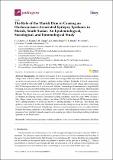| dc.identifier.citation | Lakwo, T. L., Raimon, S., Tionga, M., Siewe Fodjo, J. N., Alinda, P., Sebit, W. J., Carter, J. Y., & Colebunders, R. (2020). The Role of the Maridi Dam in Causing an Onchocerciasis-Associated Epilepsy Epidemic in Maridi, South Sudan: An Epidemiological, Sociological, and Entomological Study. Pathogens (Basel, Switzerland), 9(4), 315. https://doi.org/10.3390/pathogens9040315 | en_US |
| dc.description.abstract | Background: An epilepsy prevalence of 4.4% was documented in onchocerciasis-endemic villages close to the Maridi River in South Sudan. We investigated the role of the Maridi dam in causing an onchocerciasis-associated epilepsy epidemic in these villages. Methods: Affected communities were visited in November 2019 to conduct focus group discussions with village elders and assess the OV16 seroprevalence in 3- to 9-year-old children. Entomological assessments to map blackfly breeding sites and determine biting rates around the Maridi River were conducted. Historical data regarding various activities at the Maridi dam were obtained from the administrative authorities. Results: The Maridi dam was constructed in 1954-1955. Village elders reported an increasing number of children developing epilepsy, including nodding syndrome, from the early 1990s. Kazana 2 (the village closest to the dam; epilepsy prevalence 11.9%) had the highest OV16 seroprevalence: 40.0% among children 3-6 years old and 66.7% among children 7-9 years old. The Maridi dam spillway was found to be the only Simulium damnosum breeding site along the river, with biting rates reaching 202 flies/man/h. Conclusion: Onchocerciasis transmission rates are high in Maridi. Suitable breeding conditions at the Maridi dam, coupled with suboptimal onchocerciasis control measures, have probably played a major role in causing an epilepsy (including nodding syndrome) epidemic in the Maridi area. | en_US |

